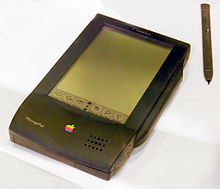1994–1997: Attempts at reinvention
By the early 1990s, Apple was developing alternative platforms to the Macintosh, such as the A/UX. Apple had also begun to experiment in providing a Mac-only online portal which they called eWorld, developed in collaboration with America Online and designed as a Mac-friendly alternative to other online services such as CompuServe. The Macintosh platform itself was becoming outdated since it was not built for multitasking, and several important software routines were programmed directly into the hardware. In addition, Apple was facing competition from OS/2 and UNIX vendors like Sun Microsystems. The Macintosh would need to be replaced by a new platform, or reworked to run on more powerful hardware.[51]
In 1994, Apple allied with IBM and Motorola in the AIM alliance. The goal was to create a new computing platform (the PowerPC Reference Platform), which would use IBM and Motorola hardware coupled with Apple's software. The AIM alliance hoped that PReP's performance and Apple's software would leave the PC far behind, thus countering Microsoft. The same year, Apple introduced the Power Macintosh, the first of many Apple computers to use IBM's PowerPCprocessor.[52]
In 1996, Michael Spindler was replaced by Gil Amelio as CEO. Gil Amelio made many changes at Apple, including massive layoffs.[53] After multiple failed attempts to improve Mac OS, first with the Taligent project, then later with Copland and Gershwin, Amelio chose to purchase NeXT and its NeXTSTEPoperating system, bringing Steve Jobs back to Apple as an advisor.[54] On July 9, 1997, Gil Amelio was ousted by the board of directors after overseeing a three-year record-low stock price and crippling financial losses. Jobs became the interim CEO and began restructuring the company's product line.
At the 1997 Macworld Expo, Steve Jobs announced that Apple would join Microsoft to release new versions of Microsoft Office for the Macintosh, and that Microsoft made a $150 million investment in non-voting Apple stock.[55]
On November 10, 1997, Apple introduced the Apple Store, tied to a new build-to-order manufacturing strategy.[56][57
